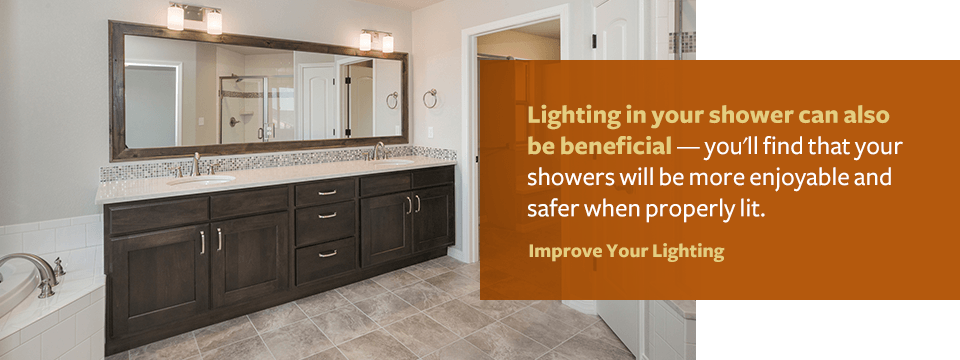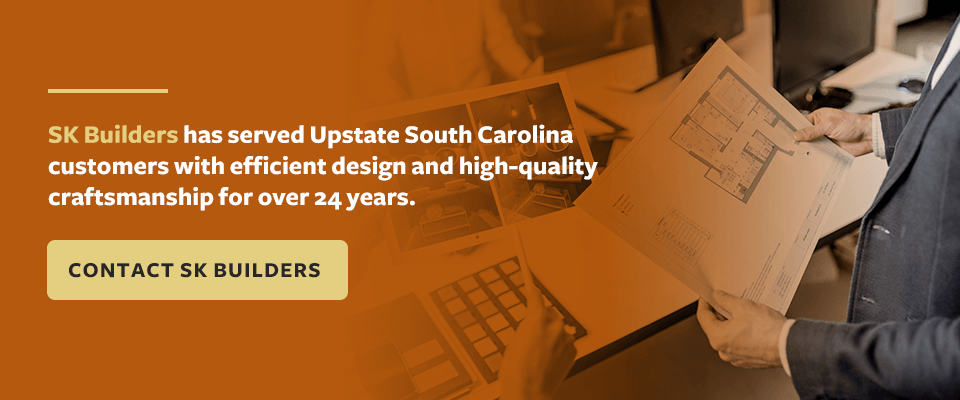Bathroom Design Ideas

March 16, 2020
Bathroom Design Ideas
Designing the perfect bathroom is no easy feat, as there are many things to consider when selecting surface materials, fixtures, cabinetry, plumbing, and electrical needs. Whether you're designing a new bathroom or remodeling an existing one, consider the following renovation ideas to make your bathroom space more functional, efficient and stylish.
1. Install Textured, Small Tiles on the Shower Floor
Small, textured shower tiles and the extra grouting they provide will help prevent you from slipping when the floor is wet and soapy. Modern bathroom tiles can be cleaned more easily and feature grouts that resist humidity, mold, and stains.
Porcelain and ceramic tiles provide a wide variety of decorating possibilities. If you want to go for a high visual impact, you can mix and match various colors and patterns. If you want to go with something more harmonious and understated, opt for one pattern and color.
2. Put in a Hidden-Tank, Low-Flow Toilet
These toilets have their water storage tanks hidden inside the wall, which provides several benefits. The greatest advantage is perhaps that they save space, making them a great choice for smaller bathrooms. Low-flow models also conserve water, meaning that they can increase the value of your home. They also work well in virtually all styles of bathroom, although they're especially appropriate for contemporary and modern decors. Keep in mind, however, that maintaining them can be a bit difficult, as it is more difficult to access the tank if it needs attention.
Another type of tankless toilet is equipped with a pressure valve, which is often seen in public bathrooms and commercial settings. While this style is an option for your home, it is noisy and can make your bathroom feel somewhat industrial.
3. Install 2-Inch Plumbing Drain Pipes
Most bathrooms feature pipes with diameters of 1 1/2 or 1 1/4 inches, but this kind of pipe clogs easily, especially if several people are using a single bath or shower. Opting for 2-inch drain pipes, which cost no more than their smaller counterparts, will improve the drainage quality of your bathroom dramatically.
4. Install a Recessed Medicine Cabinet
Increase your storage space and achieve a sleeker appearance by installing a recessed medicine cabinet over your vanity. This improvement is particularly useful is your vanity is shallow. The additional wall framing required to install a recessed cabinet is also cheap relative to the cost of a complete bathroom renovation.
5. Improve Your Lighting
Generally speaking, bathrooms do not have much access to natural light, and therefore need great lighting. We recommend that your main lights have a dimmer, as most would agree that taking a relaxing bath in full artificial light is not very atmospheric. A dimmer allows you to set the mood you want.
One fresh bathroom lighting idea to consider is adding recessed lighting fixtures surrounding your mirror, which will provide you with the best possible lighting while you do your hair, shave or apply make-up.

Lighting in your shower can also be beneficial — you'll find that your showers will be more enjoyable and safer when properly lit.
6. Install a Bathtub Only If You Need It
When designing your bathroom, you may think that a tub is an indispensable fixture, but it really depends on whether you actually take baths. Don't make the mistake of adding a tub just because you feel you "should." While some professionals argue that bathrooms with tubs offer more appeal to potential buyers than those with just showers, the truth is that bathtubs are not as important to buyers these days.
Regardless of what future prospective buyers may think, your main concern should be how you plan to use your bathroom in the upcoming years. If you're a fan of baths, then include a tub, but if baths are something you rarely or never take, you'll probably be better off if you just install a big shower instead.
Bathtubs are certainly more appealing to prospective buyers with children, but if your home already has another bathroom with a tub, there's no reason to add one to your bathroom remodel if you don't take baths.
7. Put a Window in Your Shower
Bathrooms can be difficult to keep clean, and this is often because humidity gets trapped as a result of poor or inadequate ventilation. While a high-quality bathroom fan can make a difference, natural ventilation is always the most effective kind of ventilation.
Shower windows help keep the bathroom free of mildew and mold, especially if you leave your bathroom door open after you use it. Windows in the shower are also beneficial in that they let natural light in, which is both attractive and makes the shower safer.
Speak with your contractor or architect about the window type that is most appropriate for your bathroom. You may also want frosted glass for your privacy.
8. Choose the Right Bathroom Flooring
When considering different bathroom flooring ideas, think about how each option will perform when exposed to lots of water, which will be the norm. You'll also need to consider a few other factors, including appearance, durability, cost, and ease of installation. Here are the top options to consider:

1. Porcelain or Ceramic Tile
Porcelain or ceramic tile is a great choice for bathroom flooring — it's stylish, cost-effective and, most importantly, waterproof. It also has a textured, rich and solid feel like stone and is cost-effective like vinyl.
One question you might be asking yourself is, which is better, porcelain or ceramic? And are there any real differences between them? The answer depends on whether or not your bathroom has bathing facilities. Porcelain belongs to the general family of ceramic tile and is only labeled as "porcelain" if its water absorption rate is equal or less than 0.5%. So if your bathroom is a powder room or half bathroom, you don't need to buy porcelain as there won't be any bathing facilities.
The pros of ceramic tile include:
- There is a wide variety of choices. Ceramic tiles come in an astounding array of types, meaning that it's easy to make your bathroom floor idea a reality. Some varieties even mimic stone or wood. The tiles are also available in many sizes and shapes, including rectangular, square, octagonal and hexagonal. If you want smaller tiles, you can buy them pre-mounted on mesh sheets, which means that the tiles don't need to be set individually.
- It's compatible with radiant heating. Radiant heating can easily be laid underneath the tile.
- It's easy to clean. Ceramic tiles are easy to clean and are resistant to standing pools of water.
Ceramic tile is not without its disadvantages, however:
- It's cold and hard. Like stone, tile is cold underfoot. It's also hard, which makes it difficult to stand on for longer periods.
- It's slippery. Tiles, especially larger ones, can pose a slipping hazard. However, if you choose smaller tiles, there will be a higher grout-to-tile ratio, meaning you will be less likely to slip because the grout serves as a non-skid surface.
2. Vinyl Flooring
Vinyl, which is available in plank, sheet or tile, has been one of the top choices for bathrooms for many years. If you're expecting extremely large amounts of water, as is often the case with children's bathrooms, then you'll want to consider sheet vinyl flooring. It is available in very large sizes, so you can install it in a smaller bathroom without any seams. Luxury vinyl plank flooring is also a popular choice and is available in widths of approximately 5 inches and lengths of about 48 inches. Installing vinyl flooring is easy and homeowners can do it themselves. Due to its popularity, vinyl comes in thousands of styles.
3. Natural Stone
Natural stone is durable, hard and attractive, which makes it an excellent choice for your bathroom if you have room in your budget. It also boosts the resale value of your home.
However, natural stone does have a few disadvantages. It typically has a higher cost than ceramic tiles, and certain options, such as granite, marble, and limestone, have moisture problems. Stone can also be slippery and is cold under your feet. You can install radiant heating underneath to make them warmer, and you can mitigate the slipperiness by sandblasting or buying naturally textured stone like slate.
Installing natural stone in your bathroom is difficult for most homeowners to do themselves and should be left to professionals.
4. Choose the Right Bathroom Paint
The color of paint you choose can have a great impact on the atmosphere of your bathroom. Whether you'd like to create a bright space to start off your day the right way or envision a calming, serene space to relax, the right shade of paint can help you achieve the mood you want.
When considering bathroom paint ideas, don't forget to account for the damp and humid conditions that occur in most bathrooms. Steamy showers and splashes from sinks can cause moisture to end up on the walls, so the paint you pick will need to withstand these conditions and be resistant to mildew.
We also recommend that you choose latex paint over oil paint. Although oil paint is known to be durable and withstand scrubbing, it requires mineral spirits for clean-up, dries slowly and releases large amounts of volatile organic compounds (VOCs). Oil paint may also yellow with age, especially in places with low light.
Latex paint works vastly better in bathrooms, and many formulas available today offer much better moisture resistance and durability. However, if you opt for water-based latex paint, make sure to choose a washable paint. Washable varieties tend to have a molecular structure that is tighter and cannot be penetrated by water, which means that you can scrub residue and stains away without having to worry about moisture from the scrubbing ruining the paint.
Latex paint is quicker to dry and easier to use, and water-based paint allows you to clean spills and brushes with water.
5. Choose the Best Finish
Choosing the appropriate finish for your bathroom paint is also crucial. The finish, which determines how shiny the paint will be, is more than an aesthetic choice — it also determines how mold-resistant and durable the walls will be.
Flat paints contain more pigment particles and fewer binders and resin. The result is that these paints possess a lower luster and rich color, but they're also more susceptible to the infiltration of moisture. They're also difficult to clean. For these reasons, flat finishes are not recommended for bathrooms.
However, some flat paints are specifically made for use in bathrooms. If you choose one of these more durable and mildew-resistant paints, you might be able to use a flat finish without running into problems. These paints tend to be pricey, and we don't suggest that you choose one over regular latex paint unless you're absolutely set on a flat finish for your bathroom.
The most appropriate finish for bathrooms is either gloss or semi-gloss. Either one of these will give a finish with a moderate shine and will resist absorbing excess moisture that causes mildew to grow. This resistance makes sit easier for you to wash and scrub your walls and helps you keep your bathroom cleaner.
Note that, if you're repainting your bathroom, you should never paint on top of mildew growth. Before you paint the bathroom, take all the necessary steps to remove the mildew as well as seal it to keep more from growing in the future.
To do this, the most common method is to use a water and bleach solution to scrub off the existing mildew. Make sure you use gloves and a respirator and keep the bathroom well-ventilated. Then, apply a high-quality mildew-resistant primer before you move on to applying the paint.


